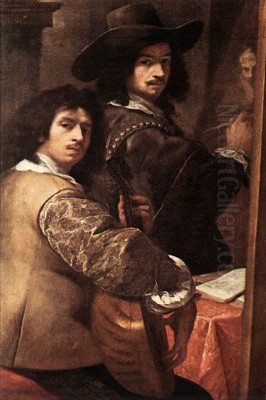
Carlo Francesco Nuvolone stands as a significant figure in the rich tapestry of Italian Baroque art, particularly within the vibrant artistic milieu of 17th-century Lombardy. Born in Milan in 1609 and active primarily in his native city and the surrounding region, Nuvolone carved out a distinct identity as a painter celebrated for his sensitive handling of religious and secular themes, his mastery of color and light, and his ability to convey profound emotion. His career unfolded during a period of dynamic artistic transition, and his work reflects both the lingering elegance of Mannerism and the burgeoning drama and dynamism of the Baroque.
An Artistic Heritage: Family and Formation
Carlo Francesco Nuvolone was born into a family deeply rooted in the practice of painting. His father, Panfilo Nuvolone (1581-1651), was a respected painter associated with the late Mannerist style. Panfilo was primarily active in Cremona and Mantua, known for his religious works and, notably, for his contributions to the genre of still life painting, particularly fruit compositions. This familial environment undoubtedly provided Carlo Francesco with his earliest exposure to artistic techniques and the life of a professional painter.
Seeking formal training beyond his father's workshop, the young Nuvolone enrolled in the prestigious Accademia Ambrosiana in Milan. This academy, founded by Cardinal Federico Borromeo and closely associated with the spirit of the Counter-Reformation, was a crucible of artistic talent in Lombardy. Crucially, Nuvolone studied under the guidance of Giovanni Battista Crespi, more famously known as Il Cerano (c. 1573–1632). Cerano was a leading figure in Milanese painting, known for his intense piety, dramatic compositions, and often somber palette, deeply influencing the generation of artists emerging in the early Seicento.
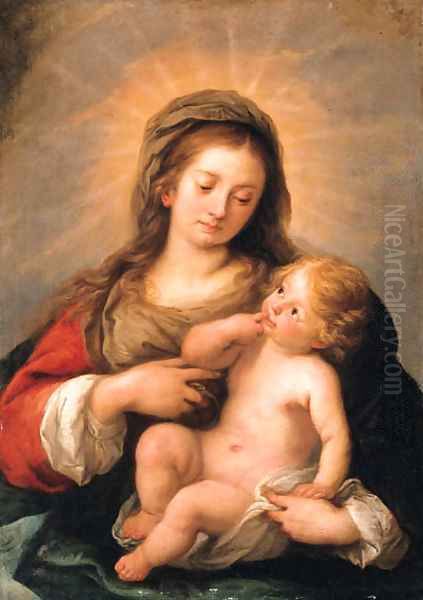
At the Accademia Ambrosiana, Nuvolone interacted with other significant talents who would shape the course of Lombard art. Among his contemporaries and fellow students were Daniele Crespi (no direct relation to Cerano, c. 1598–1630) and Giulio Cesare Procaccini (1574–1625). Daniele Crespi was noted for his sober realism and penetrating portraiture, while Procaccini, alongside Cerano and Morazzone, formed the triumvirate often seen as defining the Milanese response to early Baroque impulses, characterized by intense emotionalism and dynamic movement. These interactions and the tutelage of Cerano provided Nuvolone with a solid foundation in the prevailing Lombard artistic currents.
A Confluence of Influences
While his training under Cerano and exposure to the works of Daniele Crespi and Giulio Cesare Procaccini were formative, Carlo Francesco Nuvolone's artistic vision evolved through the absorption of a wider range of influences. The artistic landscape of Milan in the early 17th century was receptive to various stimuli, both local and international. Nuvolone proved adept at synthesizing these diverse elements into a personal and recognizable style.
A significant impact came from the great masters of the Flemish Baroque, Peter Paul Rubens (1577–1640) and his brilliant pupil Anthony van Dyck (1599–1641). Although it's unclear if Nuvolone travelled extensively, the influence of their work, known through originals or copies circulating in Italy, is palpable. From Rubens, one might discern an inspiration for dynamic compositions and a certain richness of color, while Van Dyck's elegant portraiture and refined, fluid brushwork seem to resonate in Nuvolone's own approach to depicting figures, particularly in his portraits and more graceful religious scenes.
Furthermore, Nuvolone looked towards the developments emanating from Bologna and Rome. The influence of Bolognese masters like Guido Reni (1575–1642) and Guercino (Giovanni Francesco Barbieri, 1591–1666) is often cited. Reni's classical grace, idealized figures, and light, silvery palette appear to have tempered the sometimes darker Lombard tendencies in Nuvolone's work, guiding him towards a softer, more lyrical expression. Guercino's mastery of chiaroscuro and his ability to convey tender human emotion within dramatic religious narratives also seem to have left their mark. Even the High Renaissance master Raphael (1483-1520) is noted as an influence, particularly visible in the harmonious compositions and gentle intimacy found in some of Nuvolone's depictions of the Madonna and Child.
Evolution of a Style: From Drama to Grace
Carlo Francesco Nuvolone's artistic journey reflects a stylistic evolution common among artists bridging the early and high Baroque periods. His earlier works often retain some of the dramatic intensity and darker tonalities associated with his teacher, Cerano, and the broader Lombard tradition, which emphasized pathos and realism, partly influenced by the earlier naturalism of Caravaggio. These initial paintings might exhibit strong contrasts of light and shadow (chiaroscuro) and a focus on the emotional gravity of religious narratives.
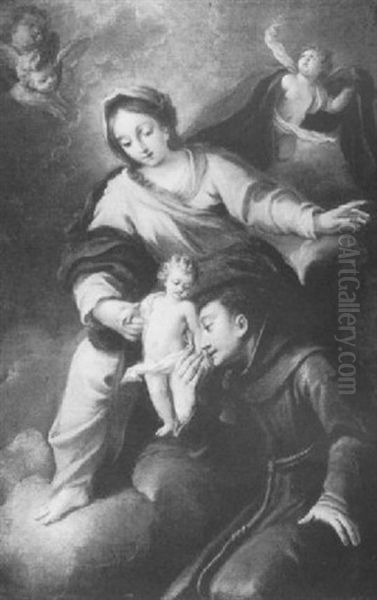
However, as his career progressed, particularly from the 1640s onwards, Nuvolone's style shifted towards a more fully developed Baroque sensibility, characterized by greater softness, fluidity, and a brighter, richer palette. This transition aligns with the broader evolution of Lombard painting, moving towards a more decorative and graceful interpretation of Baroque ideals. The influence of Procaccini's legacy, perhaps reinforced by exposure to Reni and Van Dyck, becomes more apparent.
His mature style is often praised for its delicate handling of light, creating soft, atmospheric effects rather than harsh contrasts. Brushwork becomes more fluid and visible, contributing to the vibrancy of the surface. Figures are rendered with an elegant poise, and emotional expression, while still central, often tends towards tenderness and grace rather than intense anguish. He demonstrated a remarkable ability to blend Mannerist refinement in figure drawing with Baroque dynamism in composition and color. This synthesis resulted in works that were both emotionally engaging and aesthetically pleasing, finding favour with patrons.
Themes and Subject Matter: Sacred and Secular
Carlo Francesco Nuvolone was a versatile artist who addressed a wide range of subjects, catering to the demands of both ecclesiastical and private patrons. Religious themes formed the core of his output, reflecting the deeply Catholic environment of Counter-Reformation Milan. He produced numerous altarpieces and devotional paintings for churches and private chapels.
Frequent subjects included the Madonna and Child, the Holy Family, and scenes from the lives of saints. His depictions of the Virgin Mary are often noted for their tenderness and maternal warmth, rendered with soft modeling and harmonious colors. He painted various saints, including popular figures like Saint Anthony of Padua, often shown in moments of divine ecstasy or miraculous intervention. Large-scale narrative compositions, such as the Assumption of the Virgin, allowed him to deploy his skills in handling multi-figure arrangements and creating a sense of celestial grandeur.
Beyond religious commissions, Nuvolone was also an accomplished portrait painter. He captured the likenesses of Milanese aristocrats and notable figures, often imbuing these portraits with a sense of dignity and psychological presence, likely benefiting from the influence of Van Dyck's portraiture style. Although less documented than his religious works, evidence suggests he also engaged with secular and mythological themes, contributing to the decoration of private residences. The mention of his father's specialization in still life raises the possibility that Carlo Francesco might have occasionally painted in this genre, though he is not primarily known for it. His involvement in fresco painting, such as the documented work at Varese, further demonstrates his versatility across different media and scales.
Representative Works: A Glimpse into Nuvolone's Artistry

Several key works help illustrate the characteristics of Carlo Francesco Nuvolone's style and thematic concerns.
His depictions of the Madonna and Child are numerous and highly regarded. One notable example, dated circa 1650-1662 and housed in the Walters Art Museum, Baltimore, showcases his mature style. The painting emphasizes the tender, intimate relationship between mother and child. The figures are rendered with soft contours and gentle expressions. The influence of Raphael might be seen in the balanced composition and idealized grace, while the soft lighting and warm palette are characteristic of Nuvolone's Baroque sensibility.
The Holy Family was another recurrent theme. Works depicting Joseph, Mary, and the young Jesus allowed Nuvolone to explore familial tenderness within a sacred context. A painting of this subject dated 1662, near the end of his life, would likely represent the culmination of his stylistic development, emphasizing harmony, grace, and subtle emotional interplay.
The Assumption of the Virgin with Angels demonstrates his ability to handle complex, multi-figure compositions with a sense of divine spectacle. Such works typically feature the Virgin ascending to heaven amidst swirling clouds and jubilant angels. Nuvolone's versions are noted for their soft brushwork, graded colors creating atmospheric depth, and the elegant rendering of the figures, combining religious fervor with Baroque elegance.
A painting identified as Saint Anthony of Padua with the Infant Jesus is sometimes suggested as a possible self-portrait, showcasing his mastery in capturing facial features and expressions with nuanced light and shadow. Whether a self-portrait or not, such works highlight his skill in rendering individual character and devotional intensity.
His contribution to the Sacro Monte (Sacred Mountain) of Varese, specifically frescoes in the Fifth Chapel depicting scenes related to the Mystery of the Rosary, underscores his role in major decorative projects in Lombardy. These large-scale works required compositional skill and the ability to integrate painting within an architectural setting.
The painting Agar e l'angelo (Hagar and the Angel), documented in a 2011 auction, provides an example of his treatment of Old Testament subjects, likely rendered with the characteristic emotional sensitivity and refined technique of his mature period. Its provenance, including the Graf Palffy collection in Vienna, points to the appreciation of his work by European collectors.
Collaboration and Workshop Practices
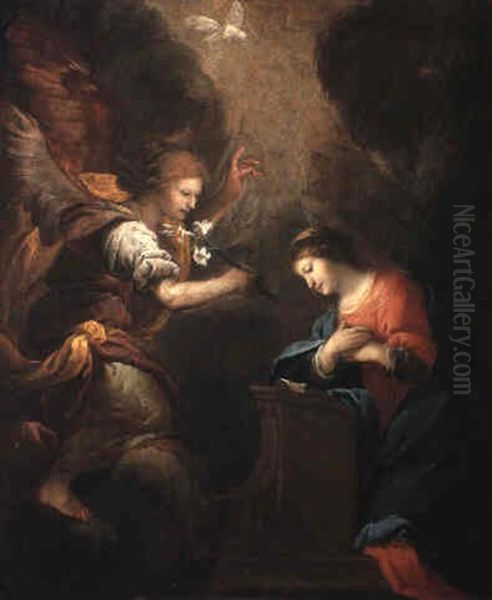
The Nuvolone family operated as something of an artistic dynasty. Carlo Francesco frequently collaborated with his younger brother, Giuseppe Nuvolone (1619–1703). Giuseppe was also a painter, heavily influenced by Carlo Francesco, and their styles can sometimes be difficult to distinguish, particularly in large workshop productions.
While sources suggest Giuseppe's individual work might have been of lesser quality than his brother's, he was known for a rich color palette and played a significant role in continuing and disseminating the Nuvolone family style and the broader Lombard Baroque idiom through the later 17th century. Their collaboration likely extended to large commissions, where a workshop structure would have been necessary to fulfill contracts for extensive fresco cycles or multiple altarpieces. This practice was common in the Baroque era, allowing principal masters to oversee projects while relying on assistants and collaborators for execution.
Patronage, Legacy, and Historical Reputation
Carlo Francesco Nuvolone enjoyed considerable success during his lifetime, securing commissions from important religious institutions and private patrons in Milan and across Lombardy. His ability to create works that were both devout and aesthetically refined appealed to the tastes of the era. His paintings adorned churches, chapels, and the collections of the Milanese nobility.
His reputation endured after his death in Milan in 1662, at the relatively young age of 53. He is consistently regarded as one of the leading exponents of the Lombard school of painting in the mid-17th century. Art historians recognize him as a key interpreter of the Milanese Baroque, successfully integrating local traditions with broader Italian and European influences, particularly those of Reni, Guercino, Van Dyck, and Rubens.
His influence extended through his brother Giuseppe and potentially other pupils or followers within his workshop. His works continued to be appreciated by collectors, as evidenced by their presence in historical inventories and their appearance in the art market over the centuries.
Collections and Market Presence
Today, works by Carlo Francesco Nuvolone are held in numerous public and private collections across Italy and internationally. Museums such as the Pinacoteca di Brera in Milan, the Walters Art Museum in Baltimore, and various diocesan museums and churches in Lombardy preserve important examples of his oeuvre.
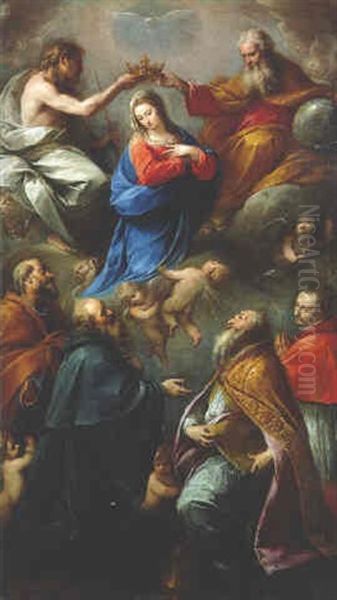
His paintings also appear periodically on the art market, attesting to continued collector interest. Auction records provide insights into the valuation of his work. For instance, the aforementioned Agar e l'angelo carried an estimate of €3,000-€5,000 in a 2011 Vienna sale. A Madonna and Child measuring 128 x 96.5 cm was estimated at €8,000-€13,000 in another sale. More ambitiously, a work described as Madonna and Child with saints was offered at Dreweatts in May 2021 with a substantial estimate, indicating that major works attributed to him can command significant prices. These records confirm his established position within the Old Master market.
Conclusion: An Enduring Lombard Master
Carlo Francesco Nuvolone remains a pivotal figure in the narrative of 17th-century Italian art. Emerging from a strong Lombard tradition shaped by figures like Cerano and the Procaccini family, he skillfully navigated the complex artistic currents of his time. By absorbing and synthesizing influences from Bologna, Rome, and Flanders, he forged a distinctive style characterized by emotional sensitivity, technical refinement, and Baroque elegance. His prolific output, spanning devotional paintings, altarpieces, portraits, and frescoes, left an indelible mark on the artistic landscape of Milan and its surrounding territories. Highly esteemed in his own time and recognized by subsequent generations, Nuvolone's legacy endures through his beautiful and often moving paintings, which continue to be appreciated in museums, churches, and collections worldwide as prime examples of Lombard Baroque artistry.